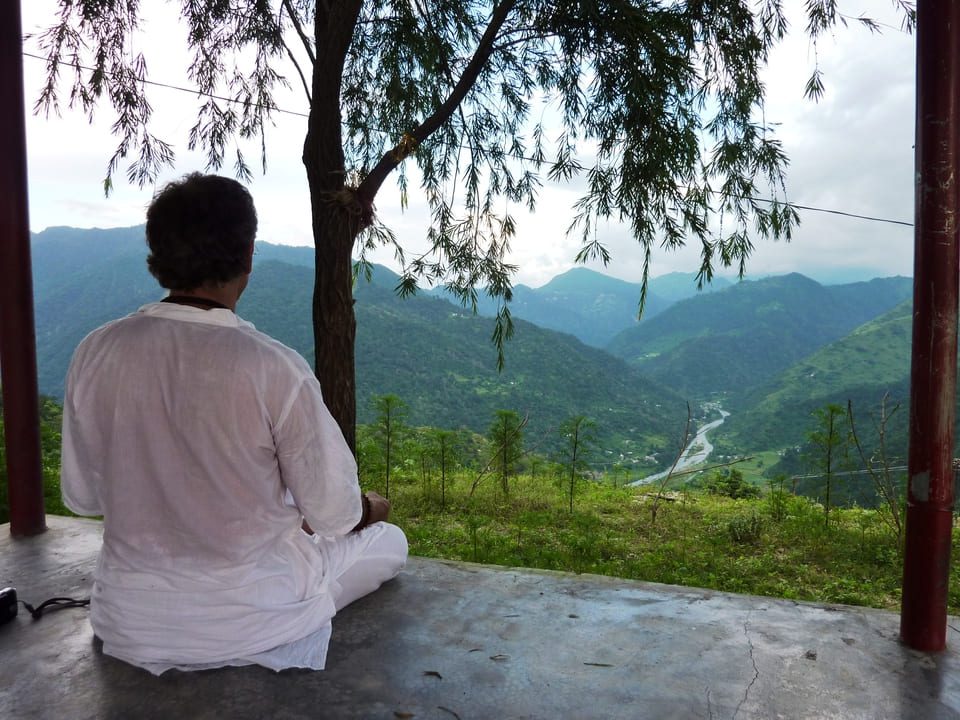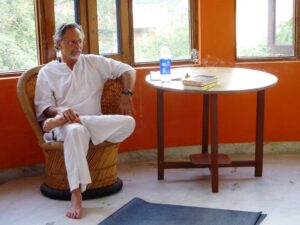All profits donated to the charities of Amma.
All profits donated to the charities of Amma.
Home » Meditation Teacher Certification » Meditation Teacher Certification Curriculum
For general information on the course, see Teacher Certification.

This Teacher Training Course will thoroughly prepare you to teach Effortless Mind, a uniquely effective meditation practice.
Your training will be four-fold:
 Topics covered in the meditation teacher training course
Topics covered in the meditation teacher training courseSpecific Meditations and Related Practices. You will learn Effortless Mind meditation (beginning through advanced stages), which includes several highly effective meditation practices that draw from the Kundalini, Raja, and Advaita Yoga traditions. You will also learn traditional “psychophysiological” techniques. These vastly deepen the experience of meditation and accelerate an individuals progress on the spiritual path. As you learn each practice, we will explore the process of teaching that practice to others. As you learn to do, you will begin to learn to teach.
Essential Principles of Meditation. What is meditation? How does it really work? What does it really do—in the body, the subtle body, the mind? What are its benefits—spiritually, mentally, physically, in relationships, and for the environment? What is the goal of meditation? What is samadhi? What are the types of samadhi? What about integration of the benefits of meditation? Where does service (seva) fit in? We will explore all of these questions, and more, in depth, giving you a thorough understanding of meditation and how to present it to others.
 Types of Meditation. There are many forms of meditation. As a teacher of Effortless Mind, you should have insight into the nature of meditation that allows you to understand the basic principles of any approach, be it mantra meditation, chakra meditation, Advaitic meditation, devotional meditation, or related practices such as japa and samyama.
Types of Meditation. There are many forms of meditation. As a teacher of Effortless Mind, you should have insight into the nature of meditation that allows you to understand the basic principles of any approach, be it mantra meditation, chakra meditation, Advaitic meditation, devotional meditation, or related practices such as japa and samyama.
The Range of Experience in Meditation. One can have a myriad of possible experiences in meditation. Without the proper guidance, a student of meditation can easily become confused or fearful, begin to resist the natural process of meditation, go off on a tangent that will spoil their meditation practice, or stop meditating altogether. As a teacher, you must understand the full range of experience that can arise in meditation and know how to guide students faithfully towards the goal.
The Development of Higher Consciousness. As a teacher you will need a clear vision of the goal of meditation, enlightenment, and the various landmarks of higher consciousness along the way, as well as potential pitfalls. We will explore the meaning of enlightenment in detail, the signs and stages of the development of higher consciousness, and its significance in relation to other spiritual traditions. We’ll also discuss the psychophysiology of evolving consciousness, what it means in terms of the conscious and subconscious mind, the storehouse of impressions of past experience, the ego, the body, and subtle body.
The Science and Use of Mantras. What are mantras? What are their effects? How do they work? How do you select a mantra for a given individual? And how should they be used?
Familiarity with the terminology and literature of the Vedic/Yoga tradition. You don’t need to become a Vedic scholar to teach meditation, but you will find it helpful to have an overview of Vedic literature, the systems of Indian Philosophy, and an understanding of important terms, for instance, the three gunas, the levels of speech, types of samadhi, the eight limbs of Yoga, Atman, Brahman, manas, buddhi, asmita, etc. We will also read from The Bhagavad-Gita, The Ribhu Gita, The Rig Veda, The Yoga Sutras, and perhaps others. (See Suggested Readings at the bottom of this page.)
“The first night after Ajayan’s personal instruction, I awoke about 3 a.m., only to find I had been meditating in my sleep in a state of bliss.” – Frank Kowalczyk
The Process of Teaching. The art of teaching is an exciting and complex process that takes years of experience to master. We will begin the process on the course. You will be given a detailed outline for teaching all the meditation practices, but you will also design your own introductory talks for different audience types. You will have the chance to hone your public speaking skills, practice teaching other participants, fielding questions, and so on.
Instructing People with Special Needs. Not all of your students will be adults in perfect emotional, physical, and psychological condition. You will need to know how to instruct people with special needs, such as someone experiencing psychological distress or instability. You will need to know how various substances (drugs, alcohol, caffeine, medications) can effect the experience of meditation, and how to advise people using such substances. You will also learn how to teach children, even as young as kindergarten age.
Relevant Lifestyle Considerations. People from all walks of life, with widely varied lifestyles, meditate. Nevertheless, as a teacher and potential guide, you should be aware that lifestyle can greatly impact the rate of growth a person experiences through meditation. Such factors as diet, routine, exercise, attitude, sexual behavior, etc. will be discussed in terms of traditional guidelines—the yamas and niyamas, and an understanding of the three gunas: rajas, sattva, and tamas.

Please see the following pages for complete details on the Meditation Teacher Training Course: